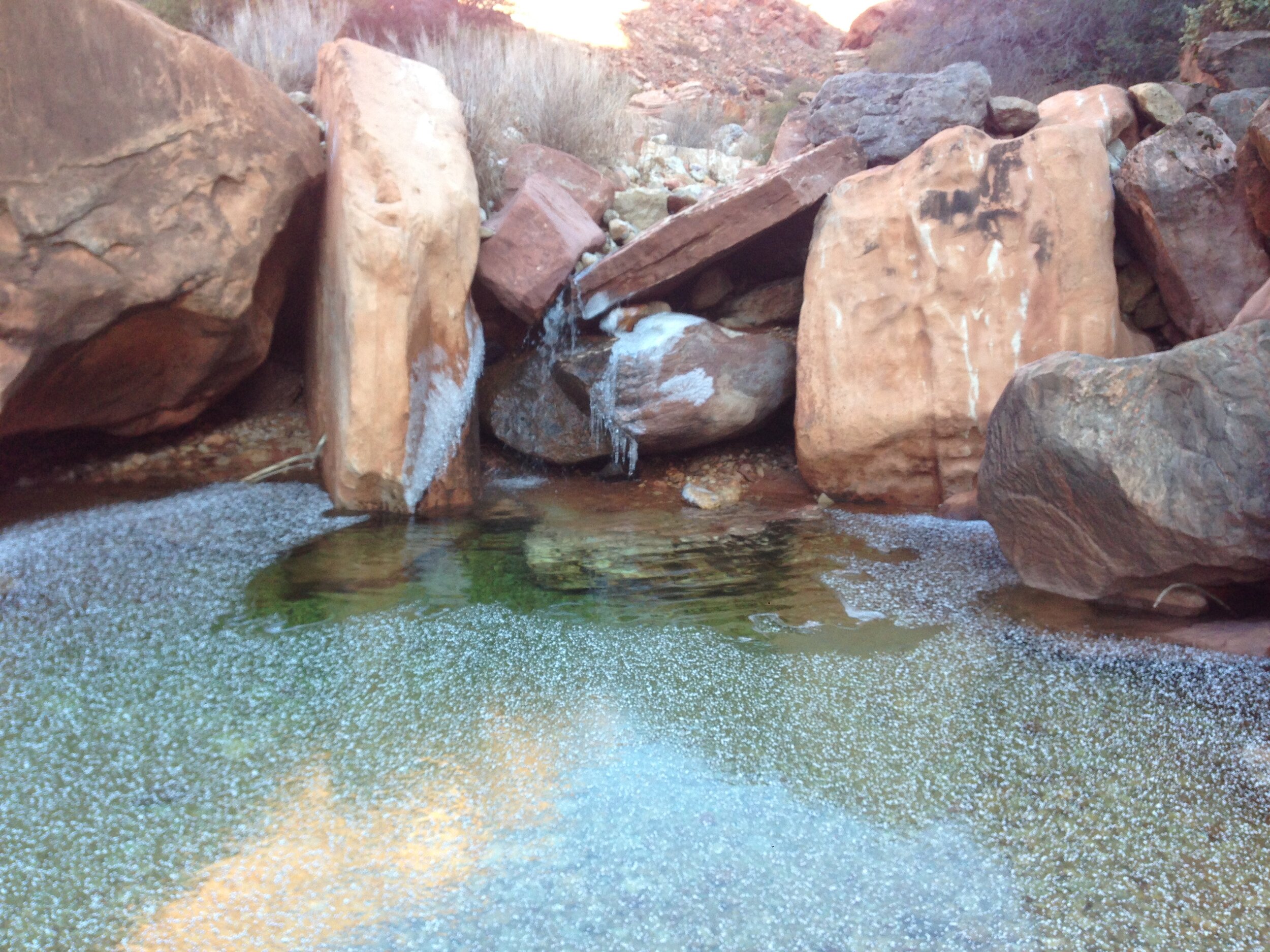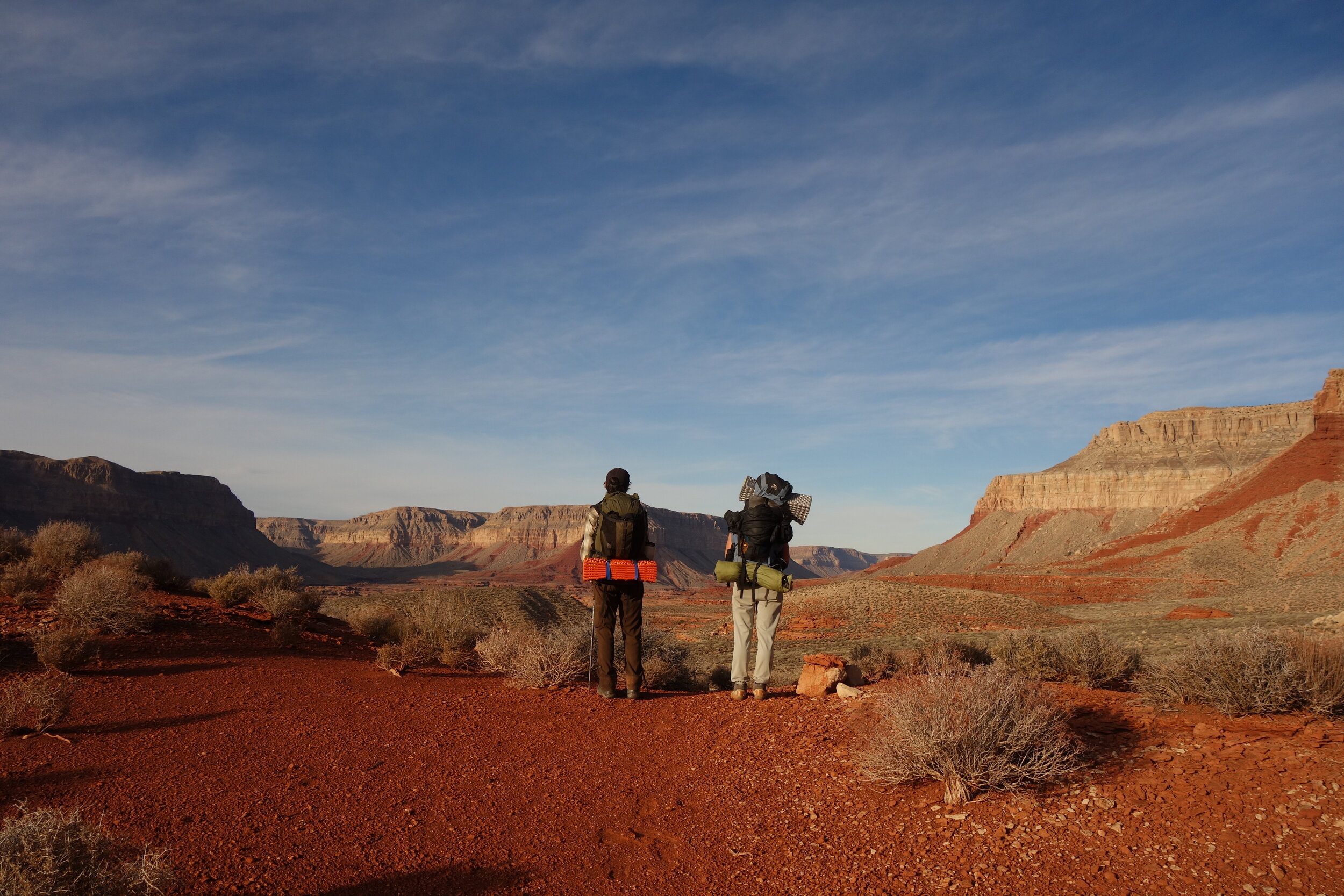When we climbed the road out of Hurricane, Utah and spilled out onto the Arizona strip we were disheartened to see the ground covered in pillows of windblown snow.
A storm had passed through on Sunday and nights had been cold and days sunny but not warm in the two days that had since passed. We turned off the pavement onto a snowy, muddy, and frozen road and motored slowly south, watching the cold land pass beside us. The dark forms of horses stood in the cold night and paced along a fence. A jackrabbit darted into the road in front of us and ran in the patch of frozen mud between the strips of snow for miles. When we sped up, it sped up, and when we stopped it stopped. When we tried to gun it to get around, it pushed its little heart as hard as it could, ears determined, legs moving like pistons, getting up to 35 miles an hour before we backed off and conceded to just follow at jackrabbit pace.
The road forked, so we pulled off into the snow and turned off the engine and waited for our friend Amber. The truck thermometer said 18, then 14, then 10. I opened the door and the cold spilled inside and I tucked my face in the hood of my jacket and slid off the seat into the snow. The stars filtered through a low fog and St. George and Las Vegas glowed in the west. After setting up my pad and sleeping bag in the back of the truck I hurried back to the cab. Porter mumbled from somewhere inside his layers of down, turned on the engine, and we read and tried to get warm.
In the morning I peered off the edge of the canyon of our imminent descent and saw what I hoped to see: that the snow ended about a thousand feet below us where red and gray striped skirts wrapped the base of limestone cliffs. With frozen paws we stuffed cold fabrics and hunks of metal and crinkly plastic things into our packs and then blazed a trail through the snow toward the edge as the sun finally crested the wispy clouds in the east that rose as it rose.
My pack felt heavier than I would have liked with a giant mummy bag, down booties, a stick of butter, and other winter luxuries inside, but winter calls for these things. It’s a time of rest, so to be moving through it was going be strange. Almost sacrilegious. And it required certain things.
It was seven and a half miles from the trailhead down a dry canyon populated with Russian thistle and big black cows, to its confluence with Kanab Creek, which I hoped would be flowing. It wasn’t. The loop was going to go clockwise, but the water, or lack thereof, spun us around, and shoved us the other way, down the wash, to do the loop counterclockwise. The first puddle lay in a crook of gravel and a muddy bank. I poked at it with my trekking pole and it shattered revealing only space beneath the surface. A façade of a puddle. There had been water, but the surface froze and the rest of it sunk into the limestone beneath. What remained was an illusion. When I encountered another fake puddle, I shattered it too. One of them was bound to have water beneath.
When we did find water, it had no frozen surface. Its repose against a wall was typical yet strange, somehow still unpredictable. It made some sense, and yet I still have little idea how to find water in the desert. The darkness below my feet—both solid and flowing—is still a mystery. We filled our containers and kept walking. The puddles became more prevalent until they began to connect. And when they began to connect, they began to flow between one another. The redwall limestone rose above us and closed in closer and closer and the wash became a creek. With each liter of water weighing two and a quarter pounds, we filled our bottles too early.
As we walked we felt like the only things awake in a land that was sleeping. Our presence intrusive but our intrusion, a ceremony. Our intent simply a recognition of the dark, the quiet. Night was closing in so we looked for a place to spend the night. Our campsite was chosen for its flatness and because the softness of the soil told us it had been thawing in the sun much of the day. Soft sand is warmer than frozen sand.
Where we walked that day, coyotes’ tracks meandered through the prickly pear, their scat, magenta piles of half-digested nopales, prickly pear fruits. But where were they now? Ringtail prints sunk into the frozen sand and ended at the creek. And when it was dark we heard things skitter along the edge of the water through the gravel but we never saw them. If the desert was sleeping, it was tossing and turning. Rocks tumbling in the dark. Prints with no form to have made them.
And all the while water seeped out and poured off the rock. On south-facing, shadowed walls it inched its way toward the ground as ice. Where the sun managed to reach, it melted, dripped, began to flow, pooled. If the desert is sleeping, this must be the desert’s dream. Preparation. Absorbing water to hold onto it when the summer heat tries to take it back.
The next day found us in shady limestone narrows for miles and miles. When we finally began to climb out of those dark tunnels the penumbra of the otherworld edged up the orange walls ahead of us keeping the sun just out of reach. I picked up my pace, feeling sore and depleted after at least 12 miles, but I wanted to catch the sun.
This sidecanyon was a frozen oasis. The water was plentiful but it was an abundance tempered with patience. The ice in the shadows still whispered “not yet, not yet.” Water poured off limestone deposits that looked like the trunks of elephants and ran clear and turquoise in pools lined with pebbles of every color. Near the top of the canyon we left a washbottom and scrambled towards the fast-escaping light. Amber stopped just before the edge of the shadow and pointed out a series of caves where people, probably Fremont, once slept, a seasonal village. Potsherds appeared around us and we made a final push to the sunlight.
There we stood in the last light of 2019. It was December 19th, almost the shortest day of the year. I leaned into the warmth and thought about how our moderately ambitious trip was made more challenging by the short days. The fact that we had to chase down the sun was revealed to be our way of celebrating the solstice. We were placing ourselves in the hands of the winter desert. We were on its schedule. We weren’t in control, and our lack of control, our chasing of sunlight became our ceremony.






